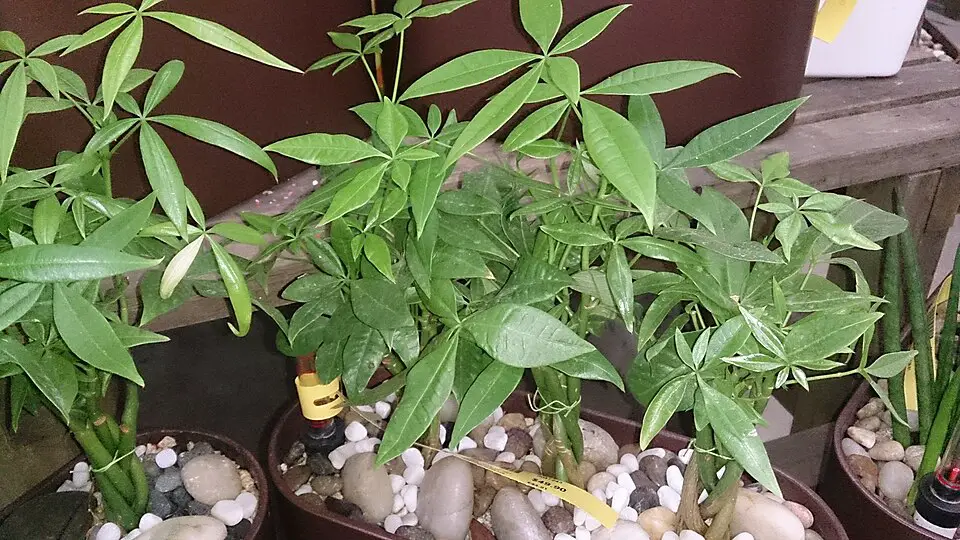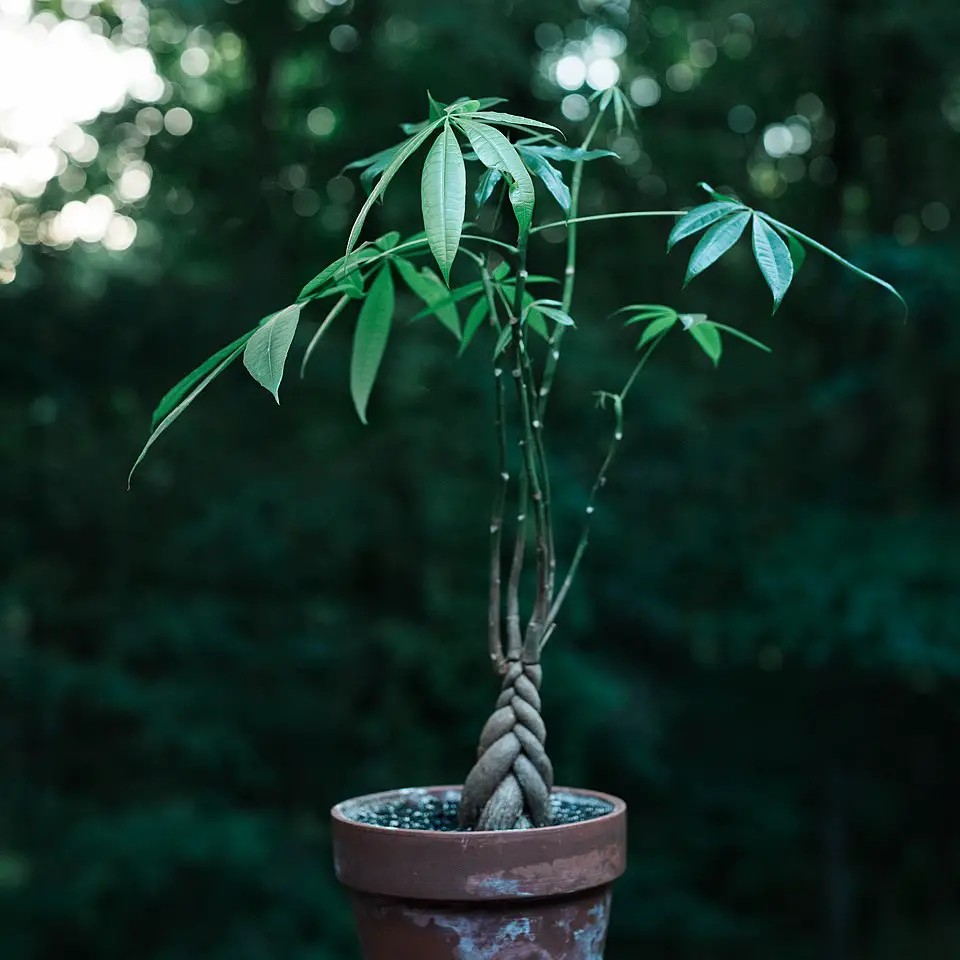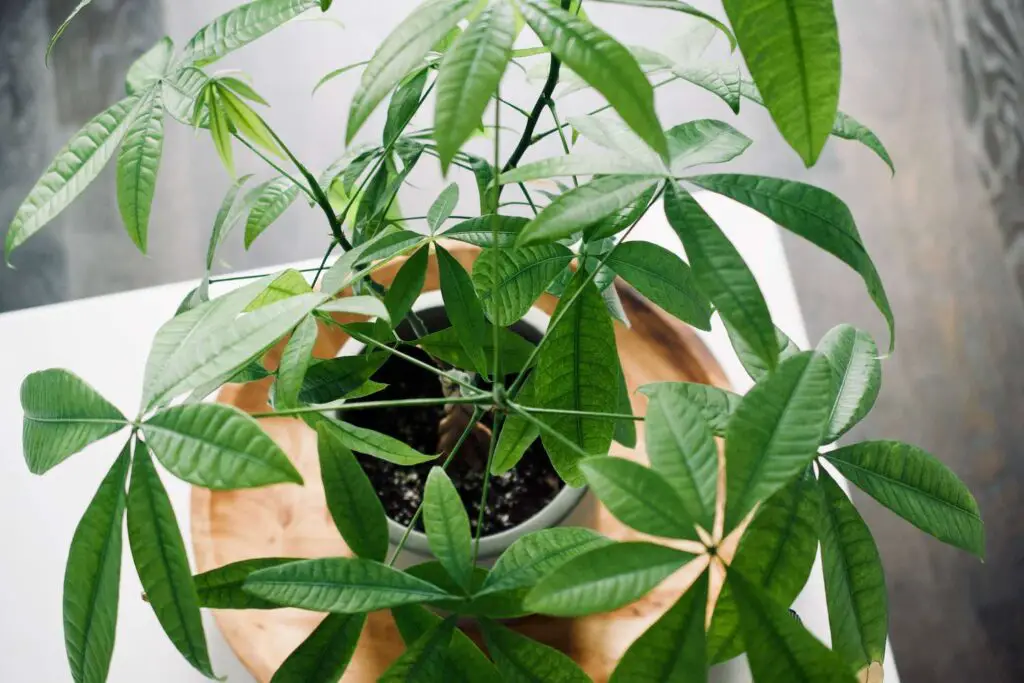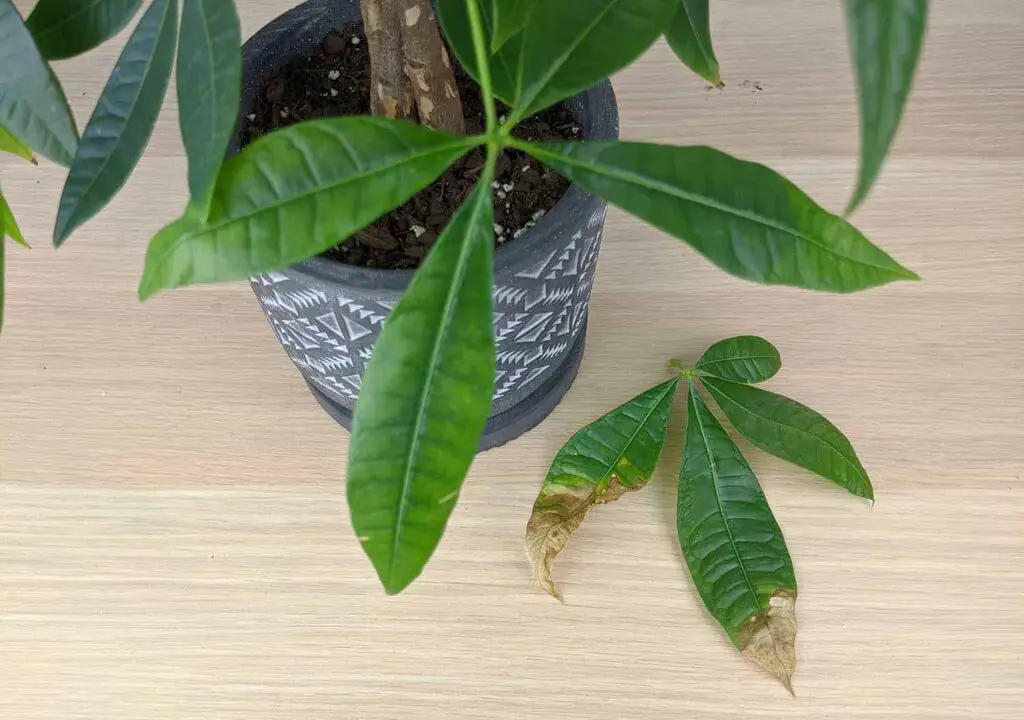Money tree root rot is a condition caused by overwatering or poor drainage, leading to yellowing leaves and a foul smell from the roots. Identifying it early is crucial. Treatment involves adjusting watering habits and repotting the plant if necessary.
Understanding Money Tree and Its Care
The money tree, scientifically known as Pachira aquatica, is a popular houseplant valued for its lush green leaves and braided trunk. It is often associated with good luck and prosperity in various cultures. While it is relatively easy to care for, it is not immune to issues like root rot. Understanding how to care for your money tree can help prevent this problem.

Root rot occurs when the roots of the plant are submerged in water for extended periods. This condition is primarily caused by overwatering or inadequate drainage. Money trees thrive in moist but well-drained soil, making proper watering techniques essential. Too much moisture can lead to the roots suffocating and eventually rotting.
Signs of Root Rot
Identifying root rot early can save your money tree from severe damage. Here are some common signs to look out for:
- Yellowing Leaves: One of the first signs of root rot is yellowing leaves. If the leaves turn yellow and start dropping, it may indicate that the roots are not absorbing nutrients properly.
- Wilting: Despite adequate watering, wilting can occur due to root damage. The plant may appear droopy as it struggles to take up water.
- Foul Odor: A rotten smell coming from the soil is a strong indicator of root rot. This odor results from decaying roots and can be quite pronounced.
- Soft or Mushy Roots: If you remove the plant from its pot, check the roots. Healthy roots should be firm and white. If they are brown, black, or mushy, root rot has set in.
Causes of Root Rot
Understanding the causes of root rot can help you avoid it in the future. Here are some common factors that contribute to this issue:

- Overwatering: Watering too frequently or using pots without drainage holes can lead to excess moisture.
- Poor Soil Quality: Soil that retains too much water or lacks aeration can suffocate roots.
- Pests: Some pests can damage roots, making them more susceptible to rot.
- Low Light Conditions: Insufficient light can weaken a plant, making it more vulnerable to diseases.
How to Treat Root Rot
If you suspect that your money tree has root rot, immediate action is necessary to save it. Here are steps you can take:
- Remove the Plant: Carefully take the money tree out of its pot and shake off the excess soil.
- Inspect the Roots: Examine the roots for signs of decay. Cut away any dark, mushy portions with sterilized scissors.
- Allow to Dry: Let the remaining healthy roots dry out for a few hours before repotting.
- Select New Soil: Use fresh, well-draining potting mix to repot your money tree.
- Water Sparingly: After repotting, water lightly. Allow the soil to dry out between waterings.
Preventing Future Root Rot
Preventing root rot is essential for maintaining a healthy money tree. Here are some tips to ensure your plant thrives:
| Tip | Description |
|---|---|
| Use Well-Draining Soil | Choose potting mix designed for drainage to prevent water retention. |
| Water Wisely | Only water when the top inch of soil feels dry to the touch. |
| Check for Drainage | Ensure pots have drainage holes to allow excess water to escape. |
| Provide Adequate Light | Place your money tree in bright, indirect sunlight for optimal growth. |
Diagnosing Root Rot in Money Trees
Once you suspect root rot, it is crucial to diagnose the problem accurately. Knowing how to distinguish root rot from other issues can help you take the right action. Here are some steps to help you with the diagnosis:

Visual Inspection
Start by visually inspecting your money tree. Look for any signs of distress, such as:
- Leaf Color: Check if the leaves have started turning yellow or brown.
- Leaf Texture: Observe if the leaves are wilting or appear limp.
- Root Condition: If you remove the plant from its pot, look closely at the roots for discoloration or softness.
Soil Examination
The condition of the soil can also provide important clues. Here are some aspects to consider:
- Moisture Level: Stick your finger into the soil. If it feels soggy or overly wet, this is a sign of potential root rot.
- Soil Quality: Assess whether the soil retains too much moisture, which can lead to root suffocation.
- Foul Smell: A rotten odor from the soil can indicate decaying roots.
Testing Drainage
Proper drainage is vital for the health of your money tree. A simple test can help you determine if drainage is an issue:
- Water the Plant: Give your money tree a good watering and observe how quickly the water drains through.
- Check the Pot: If water pools at the bottom for more than a few minutes, your pot may not have adequate drainage.
- Evaluate Soil Type: Consider whether your soil is compacted or too dense, which can impede drainage.
Treatment Options for Root Rot
If you confirm that your money tree has root rot, timely treatment is essential. Below are various methods to address this issue:

Repotting Your Money Tree
Repotting is often necessary for treating root rot. Here are steps to follow:
- Remove the Plant: Take your money tree out of its current pot carefully.
- Trim Damaged Roots: Use sterilized scissors to cut away any mushy or discolored roots.
- Select a New Pot: Choose a pot that is slightly larger and has drainage holes at the bottom.
- Add Fresh Soil: Fill the new pot with fresh, well-draining soil suitable for houseplants.
- Repot the Tree: Place your money tree in the new pot and cover with soil, ensuring it stands upright.
Aeration Techniques
Aeration can also help improve root health. Here are some techniques to consider:
- Poke Holes in Soil: Use a stick or tool to poke holes in the soil to enhance air circulation around the roots.
- Add Perlite or Sand: Mixing perlite or coarse sand into the soil can improve aeration and drainage.
Pest Control
Pests can contribute to root rot by damaging roots and creating entry points for pathogens. Here are some steps to manage pests effectively:
- Inspect Regularly: Check your plant frequently for any signs of pests such as webs, spots, or discolored leaves.
- Treat with Insecticidal Soap: If you find pests, apply insecticidal soap or neem oil according to package instructions.
- Isolate Affected Plants: If you notice infestations, isolate affected plants to prevent spreading.
Maintaining Long-term Health
After treating root rot, it’s vital to focus on maintaining the long-term health of your money tree. Consider these practices:
- Regular Watering Schedule: Establish a consistent watering routine based on the plant’s needs and environmental conditions.
- Nutrient Balance: Use a balanced fertilizer during the growing season to support overall plant health.
- Monitor Environmental Conditions: Keep an eye on humidity, light, and temperature levels to ensure they are within optimal ranges for your money tree.
By taking these steps, you can help ensure that your money tree remains healthy and resilient against issues like root rot in the future.
Common Myths About Money Tree Care
When it comes to caring for money trees, various myths and misconceptions can lead to improper treatment and maintenance. Understanding the truth behind these myths is essential for keeping your plant healthy. Here are some common myths debunked:
Myth 1: Money Trees Require Constant Moisture
Many believe that money trees thrive in constantly wet soil. In reality, overwatering is one of the primary causes of root rot. Money trees prefer their soil to dry out slightly between waterings, allowing the roots to breathe and preventing excess moisture buildup.
Myth 2: All Houseplants Need the Same Care
Each houseplant has unique care requirements. While some plants thrive in low light and high humidity, money trees prefer bright, indirect sunlight and moderate humidity levels. Understanding the specific needs of your money tree is crucial for its health.
Myth 3: Fertilizing More Means Faster Growth
Over-fertilizing can harm your money tree more than help it. Excess nutrients can lead to salt buildup in the soil, which can damage roots and affect overall plant health. It’s best to follow a balanced fertilization schedule during the growing season and avoid overdoing it.
Other Potential Problems for Money Trees
Aside from root rot, money trees can face various other issues that may affect their health. Recognizing these problems early can help you take appropriate action:
Pests
Pests such as spider mites, aphids, and mealybugs can cause significant stress to your money tree. Symptoms of pest infestations include:
- Discoloration: Leaves may turn yellow or develop spots.
- Webbing: Spider mites may leave thin webs on the leaves.
- Sticky Residue: Some pests excrete a sticky substance called honeydew, which can attract other insects.
Leaf Drop
If your money tree’s leaves are falling off, it could be due to several factors:
- Environmental Changes: Sudden changes in temperature or humidity can lead to leaf drop.
- Pest Infestation: Pests feeding on leaves may cause them to drop prematurely.
- Underwatering: Insufficient watering can also cause stress and lead to leaf loss.
Brown Leaf Tips
Browning leaf tips can be a sign of several issues:
- Low Humidity: Money trees thrive in humid environments. Low humidity can lead to brown tips.
- Nutrient Deficiency: Lack of essential nutrients can also manifest as browning.
- Over-Fertilization: Too much fertilizer can cause salt buildup, leading to brown tips on leaves.
Repotting Your Money Tree: When and How
Repotting is essential for the long-term health of your money tree. Knowing when and how to repot can significantly impact its growth:
When to Repot
You should consider repotting your money tree if you notice any of the following signs:
- Root Bound: Roots growing out of the drainage holes or circling the inside of the pot indicate it’s time to repot.
- Soil Degradation: If the soil looks compacted or has lost its nutrients, repotting will refresh it.
- Pest Infestation: If pests are present in the soil, it’s best to repot with fresh, clean soil.
How to Repot
Follow these steps for effective repotting:
- Select a New Pot: Choose a pot that is one size larger than the current one with good drainage holes.
- Prepare Fresh Soil: Use a high-quality potting mix designed for houseplants.
- Remove the Plant: Gently take your money tree out of its existing pot, being cautious not to damage the roots.
- Inspect Roots: Check for any signs of rot or disease and trim as necessary.
- Add Soil and Repot: Place some fresh soil in the new pot, position your plant, and fill in around it with more soil. Water lightly.
Regular care and timely interventions like repotting can help ensure your money tree remains healthy and vibrant for years to come.
Additional Care Tips for Money Trees
In addition to addressing root rot, there are several other care practices that can help your money tree thrive and prevent future issues. These practices focus on the overall well-being of the plant and creating a conducive environment for growth.
Humidity Levels
Money trees prefer moderate humidity levels, typically around 50-70%. Here are some ways to maintain adequate humidity:
- Use a Humidifier: Placing a humidifier near your money tree can help maintain optimal humidity levels, especially in dry climates or during winter.
- Group Plants Together: Keeping your money tree near other plants can create a microclimate with increased humidity.
- Misting: Lightly misting the leaves can also help raise humidity, but be careful not to overdo it as excess moisture on leaves can lead to fungal problems.
Proper Pruning Techniques
Regular pruning is important for maintaining the shape and health of your money tree. Here are some tips for effective pruning:
- Use Clean Tools: Always use sterilized scissors or pruning shears to prevent the spread of disease.
- Remove Dead or Yellow Leaves: Trim off any dead, yellow, or damaged leaves to encourage new growth and improve the plant’s appearance.
- Shape the Plant: If your money tree is becoming leggy, prune back long stems to promote bushier growth.
Seasonal Care Adjustments
The care requirements for your money tree may change with the seasons. Here’s how to adjust your care routine:
- Spring and Summer: During the growing season, increase watering frequency and begin fertilizing every 4-6 weeks.
- Fall and Winter: Reduce watering as the plant goes dormant. Cut back on fertilization during these months as well.
Common Questions About Money Trees
>If you are a money tree owner, you may have some questions regarding their care. Here are some frequently asked questions:
How often should I water my money tree?
The frequency of watering depends on environmental conditions. Generally, you should water when the top inch of soil feels dry. This could range from once a week to every two weeks.
Can I keep my money tree outdoors?
Money trees can be placed outdoors in warm weather, but they should be protected from direct sunlight and strong winds. Ensure they have partial shade and bring them indoors before temperatures drop below 50°F (10°C).
What should I do if my money tree is tall and leggy?
If your money tree is stretching towards light and becoming leggy, consider moving it closer to a light source. Pruning back long stems can also help promote a fuller appearance.
Final Thoughts
Caring for a money tree involves understanding its specific needs and being proactive about potential issues like root rot. By recognizing the signs early and implementing proper care techniques, you can ensure that your money tree remains healthy and vibrant.
Regular monitoring of watering habits, soil quality, and environmental conditions can help prevent problems before they arise. Additionally, debunking common myths about money tree care enables you to make informed decisions that contribute to its longevity.
Whether you’re enjoying your money tree for its aesthetic appeal or as a token of good fortune, providing the right care will reward you with a flourishing plant that brings joy for years to come. Remember that each plant is unique; adjustments to care practices may be necessary based on individual circumstances. With patience and attention, your money tree can thrive in any home.
